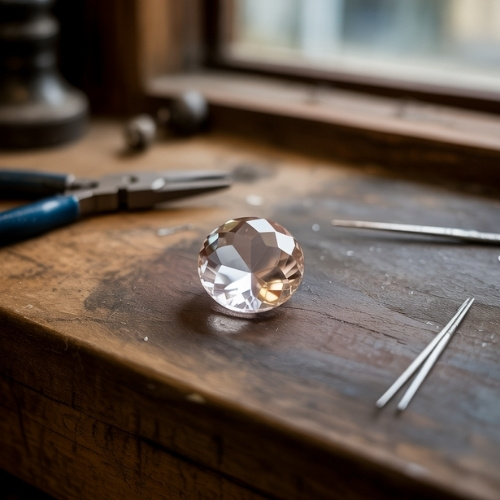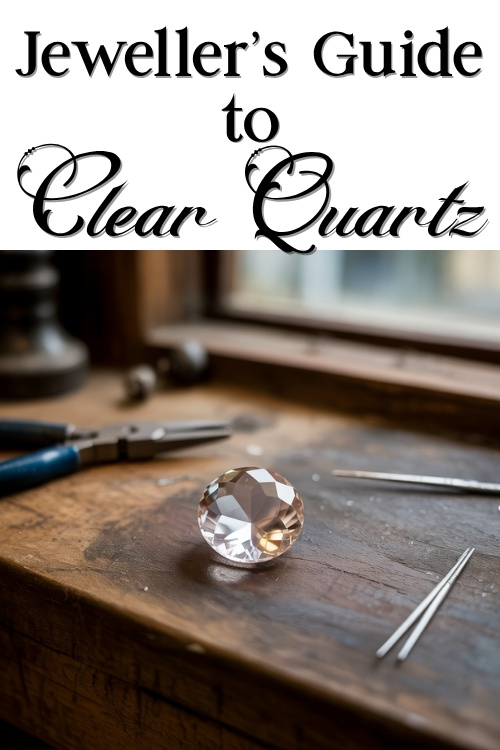Estimated reading time: 4 minutes
Cool as ice and endlessly adaptable, clear quartz is one of the most accessible and quietly captivating gems in a jeweller’s toolkit. Valued across centuries for both its clarity and energy, clear quartz offers a rare mix of beauty, affordability, and spiritual legacy, making it a favourite for both fine and fashion jewellery.
Jump to:
Basic Identification Information
Name & Synonyms:
Clear quartz; Also known as rock crystal
Species:
Quartz
Colour Range:
Colourless
Refractive Index:
1.544 – 1.553
Birefringence:
0.009
Optical Sign:
Uniaxial +
Pleochroism:
None
Specific Gravity:
2.650 to 2.655
Fluorescence:
None
Lustre:
Vitreous – When polished looks glass-like.
Clarity:
Type I
Usually eye-clean.
Gems Often Mistaken For:
Colourless topaz, colourless beryl
Mohs Hardness:
7
Wearability:
Good. Suitable for most types of jewellery with proper care.
Birthstone:
Not an official birthstone, though often used as an affordable alternative to diamond for April.
Spotting Synthetic (Lab-Grown) Clear Quartz
Lab-grown quartz is chemically identical to natural quartz and can be difficult to distinguish without equipment. That said, most synthetic quartz is created for industrial use, not jewellery.
Inclusions can offer clues: natural quartz may contain veils, fluid inclusions, or growth zoning, while synthetic stones often show tell-tale patterns such as curved growth lines or seed plate structures when viewed under magnification.
Common Treatments
Clear quartz is most often left untreated, which appeals to jewellers favouring natural materials.
However, coated or irradiated varieties do exist. These are typically sold under different trade names (e.g. “aqua aura quartz”) and display strong iridescence or unusual colours. Such treatments are visually obvious and used in entirely different design contexts.
Durability & Setting Considerations
Quartz may rank a 7 on the Mohs scale, but it’s not immune to wear. Its hardness makes it scratch-resistant to most daily surfaces, yet softer than many gemstones such as sapphire or spinel.
Clear quartz lacks cleavage, so it resists splitting under stress, but a sharp blow can still cause fracturing. When using clear quartz in rings and bracelets it’s best to protect exposed facets. A recessed setting can help preserve crisp facet edges in high-contact styles.
Caution is advised during jewellery repairs involving heat, particularly with stones that contain fluid inclusions, as thermal shock can create internal damage or clouding.
From a design perspective, its clarity makes it ideal for bold cuts and generous sizes, but the transparent nature also means flaws and setting reflections are easily visible. Use high-grade stones in open settings to celebrate their purity, or consider closed-back designs to boost brilliance.
🛍️ Explore our selection of pre-owned Clear Quartz Gemstones for your next jewellery creation.
Care Instructions
Cleaning:
Mild soap, warm water, and a soft brush are ideal.
Ultrasonic cleaners are generally safe for untreated quartz without inclusions. Avoid steam cleaning and rapid temperature changes, especially for stones with internal features.
Storage:
Store separately in a pouch or lined box. Quartz can be scratched by harder gems such as sapphire or spinel.
Daily Wear:
Clear quartz is suitable for regular wear but benefits from mindful handling. Remove rings and bracelets during strenuous activities to help prevent damage.
Market & Ethical Notes
Clear quartz is one of Earth’s most abundant minerals and is widely mined in Brazil, Madagascar, the United States, and the Swiss Alps.
Its plentiful nature, minimal processing, and low environmental footprint make it a strong ethical choice for jewellers. Most commercial specimens are natural and untreated, and traceability is often easier to achieve than with rarer stones.
🔗 Learn more about the ethical and environmental story behind Reclaimed and Recycled Gemstones.
Symbolic & Spiritual Meanings
Clear quartz is often referred to as the “master healer” in metaphysical circles. Believed to amplify energy and intention, it’s frequently used in spiritual jewellery, meditation, and crystal healing practices.
Traditionally linked to the crown chakra, clear quartz is associated with clarity of mind, spiritual awakening, and energetic balance. It’s said to enhance the properties of nearby stones, making it a natural amplifier in multi-stone pieces.
Used throughout history in ritual objects and sacred tools, its symbolism continues to resonate with modern makers and wearers alike.
🔗 Dive deeper into Clear Quartz’s Symbolic & Spiritual Meanings
Etymology
The word quartz has Germanic roots, appearing as quarz in 16th-century mining literature. Its older name, rock crystal, comes from the ancient Greek krustallos, meaning “ice”, based on the belief that this gemstone was frozen water, permanently solidified by divine force.
🔗Curious about how clear quartz was viewed in ancient cultures? Explore its fascinating myths and legends
📌 Save this jeweller’s guide to clear quartz for quick reference next time you’re working with this stunning gem.


